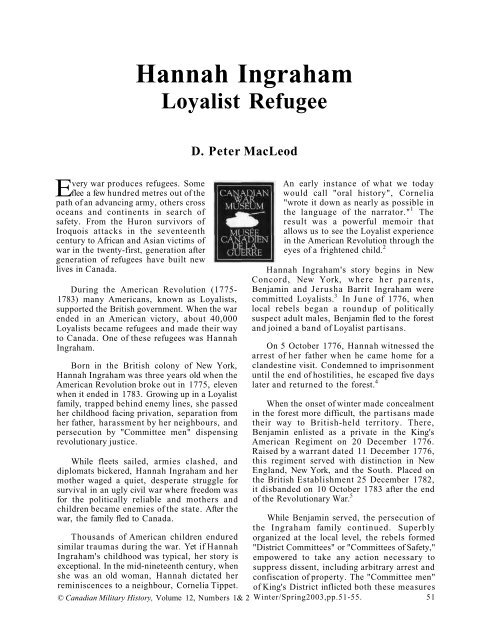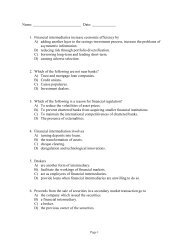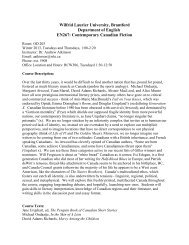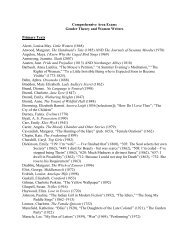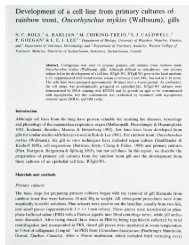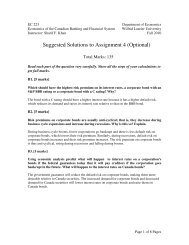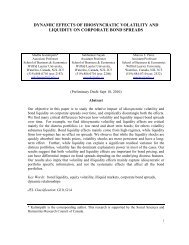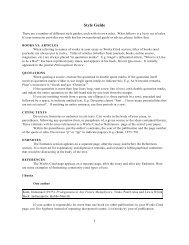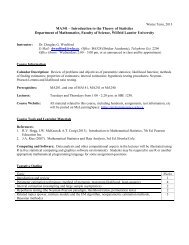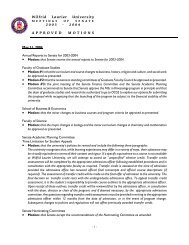D. Peter MacLeod, "Hannah Ingraham: Loyalist Refugee,"
D. Peter MacLeod, "Hannah Ingraham: Loyalist Refugee,"
D. Peter MacLeod, "Hannah Ingraham: Loyalist Refugee,"
Create successful ePaper yourself
Turn your PDF publications into a flip-book with our unique Google optimized e-Paper software.
<strong>Hannah</strong> <strong>Ingraham</strong><strong>Loyalist</strong> <strong>Refugee</strong>Every war produces refugees. Someflee a few hundred metres out of thepath of an advancing army, others crossoceans and continents in search ofsafety. From the Huron survivors ofIroquois attacks in the seventeenthcentury to African and Asian victims ofwar in the twenty-first, generation aftergeneration of refugees have built newlives in Canada.During the American Revolution (1775-1783) many Americans, known as <strong>Loyalist</strong>s,supported the British government. When the warended in an American victory, about 40,000<strong>Loyalist</strong>s became refugees and made their wayto Canada. One of these refugees was <strong>Hannah</strong><strong>Ingraham</strong>.Born in the British colony of New York,<strong>Hannah</strong> <strong>Ingraham</strong> was three years old when theAmerican Revolution broke out in 1775, elevenwhen it ended in 1783. Growing up in a <strong>Loyalist</strong>family, trapped behind enemy lines, she passedher childhood facing privation, separation fromher father, harassment by her neighbours, andpersecution by "Committee men" dispensingrevolutionary justice.While fleets sailed, armies clashed, anddiplomats bickered, <strong>Hannah</strong> <strong>Ingraham</strong> and hermother waged a quiet, desperate struggle forsurvival in an ugly civil war where freedom wasfor the politically reliable and mothers andchildren became enemies of the state. After thewar, the family fled to Canada.Thousands of American children enduredsimilar traumas during the war. Yet if <strong>Hannah</strong><strong>Ingraham</strong>'s childhood was typical, her story isexceptional. In the mid-nineteenth century, whenshe was an old woman, <strong>Hannah</strong> dictated herreminiscences to a neighbour, Cornelia Tippet.D. <strong>Peter</strong> <strong>MacLeod</strong>© Canadian Military History, Volume 12, Numbers 1& 2An early instance of what we todaywould call "oral history", Cornelia"wrote it down as nearly as possible inthe language of the narrator." 1 Theresult was a powerful memoir thatallows us to see the <strong>Loyalist</strong> experiencein the American Revolution through theeyes of a frightened child. 2<strong>Hannah</strong> <strong>Ingraham</strong>'s story begins in NewConcord, New York, where her parents,Benjamin and Jerusha Barrit <strong>Ingraham</strong> werecommitted <strong>Loyalist</strong>s. 3 In June of 1776, whenlocal rebels began a roundup of politicallysuspect adult males, Benjamin fled to the forestand joined a band of <strong>Loyalist</strong> partisans.On 5 October 1776, <strong>Hannah</strong> witnessed thearrest of her father when he came home for aclandestine visit. Condemned to imprisonmentuntil the end of hostilities, he escaped five dayslater and returned to the forest. 4When the onset of winter made concealmentin the forest more difficult, the partisans madetheir way to British-held territory. There,Benjamin enlisted as a private in the King'sAmerican Regiment on 20 December 1776.Raised by a warrant dated 11 December 1776,this regiment served with distinction in NewEngland, New York, and the South. Placed onthe British Establishment 25 December 1782,it disbanded on 10 October 1783 after the endof the Revolutionary War. 5While Benjamin served, the persecution ofthe <strong>Ingraham</strong> family continued. Superblyorganized at the local level, the rebels formed"District Committees" or "Committees of Safety,"empowered to take any action necessary tosuppress dissent, including arbitrary arrest andconfiscation of property. The "Committee men"of King's District inflicted both these measuresWinter/Spring2003,pp.51-55. 51
upon <strong>Ingraham</strong> non-combatants. After Benjamin'sdeparture, "the rebels confiscated hisfarm of 93 acres.. .They left his wife 1 cow and 4sheep, and made her pay rent for the use of thefarm." 6<strong>Hannah</strong>'s grandfather, Benjam <strong>Ingraham</strong>senior, age 63, was arrested in 1777 by the King'sDistrict Committee and held in the notorious"Fleet Prison." Confined aboard ships anchoredin the Hudson River, the <strong>Loyalist</strong> prisonerssuffered starvation and severe abuse. On 4October 1777, unable to endure this treatmentany longer, <strong>Hannah</strong>'s grandfather took an oathof allegiance to the rebel government and wonhis release. 7Other rebels were content simply to insultand humiliate <strong>Hannah</strong>'s family. Americansoldiers passing the <strong>Ingraham</strong> farm, "used tofire at a tree, and wish it was Ben <strong>Ingraham</strong>." 8When the fighting ended in 1783 with a rebeltriumph, there was no place for <strong>Hannah</strong> and herfamily in the new United States. The soldiers ofthe King's American Regiment and their familieswere evacuated from New York on the Williamand King George, part of the "Fall Fleet" thatreached Saint John on 4 October 1783. 9 Fromthere, the <strong>Ingraham</strong> family made their way upthe Saint John River to St. Ann's, the site of thefuture Fredericton. Here they settled down to livein peace for the first time in seven years.<strong>Hannah</strong> <strong>Ingraham</strong> told her story when shewas an elderly adult. The simplicity of herlanguage and the narrowness of her focus reflecta child's perspective. Yet the general accuracy ofher recollections is not in question. Another<strong>Loyalist</strong>, Mary Fisher, married to Lodewick(Lewis) Fisher of the New Jersey Volunteers,followed the same route from New York toFredericton, and produced a narrative that bothverifies many of <strong>Hannah</strong> <strong>Ingraham</strong>'s assertionsand adds numerous details. 10 Some of Mary'sown recollections will be interspersed here with<strong>Hannah</strong>'s as they complement <strong>Hannah</strong>'s and addfurther detail to the story of the loyalist refugeeexperience in New Brunswick.<strong>Hannah</strong> <strong>Ingraham</strong>'s reminiscences describehow war affected a child and her family. They lieat the heart of the story that will be told in thenew Canadian War Museum: how war shapedCanada.52Reminiscences of <strong>Hannah</strong> <strong>Ingraham</strong>1776-1783My father lived at New Concord, 11 twenty milesfrom Albany. We had a comfortable farm, plentyof cows and sheep. But when the war began andhe joined the regulars, they (the Rebels) took it allaway, sold the things, ploughs and all, and mymother was forced to pay rent for her own farm.What father had sown they took away, but whatmother raised after she paid rent they let her keep.They took away all our cows and sheep, only lether have one heifer and four sheep.Uncle [Abijah <strong>Ingraham</strong>, Benjamin's brother]had given me a sheep, and when he found we werelike to lose all, he took it away, and kept it for me.Little John, my brother [John <strong>Ingraham</strong>, born20 May 1773 12 ], had a pet lamb, and he went to theCommittee men and spoke up and said, "Won't youlet me have my lamb?" He was a little fellow, fouryears old, so they let him have it.My father was in the army seven years. Theytook grandfather prisoner and sent him on board aprison ship. Mother rode fifty miles on horseback inone day when she heard it to go to see him andtake him some money to buy some comforts. Hehad a paralytic stroke when he was there, and henever recovered, poor grandfather.My father was taken prisoner once but heescaped. The girl who was sent to take him hissupper one night told him she would leave the doorunbuttoned, and he got off to the woods, but waswandering most two months before he found thearmy again. Mother was four years without hearingof or from father, whether he was alive or dead; anyone would be hanged right up if they were caug[ht]bringing letters.Oh, they were terrible times!At last there was talk of peace and a neighborgot a letter from her husband, and one inside formother to tell her father was coming home.1783He came home on Sep. 13th itwas Friday, and said we were to go to NovaScotia, 13 that a ship was ready to take us there, sowe made all haste to get ready.
A Map of the Great River St. John & Waters by RobertCampbell. Engraved by S.I. Neele. London: RobertCampbell, 1788.Killed the cow, sold the beef, and a neighbortook home the tallow and made us a good parcel ofcandles and put plenty of beeswax in to make themhard and good.Uncle came down and thrashed [sic] our wheat,20 bushels, and grandmother came and made bagsfor the wheat, and we packed up a tub of butter, tubof pickles, and a good store of potatoes.And then one Tuesday, suddenly, the house wassurrounded by rebels and father took prisoner andcarried away. Uncle went forward and promisedthem who took him that if he might come home thenhe would answer for his being forthcoming nextmorning. But no, and I cried, and I cried, and I criedenough to kill myself that night. When morning camethey sent to say that he was free to go.We had five wagon loads carried down theHudson in a sloop, and then we went aboard thetransport that was to bring us to St. John.I was just eleven years old when we left ourfarm to come here. It was the last transport for theseason, and had in it all those who could not leavesooner.The first transport had come in May, and so hadall the summer before them to get settled.But this was the last part of September, we hada bad storm in the Bay [of Fundy], but someFrenchmen came off in a canoe and helped us. 14There were no deaths on board, but severalbabies were born. It was a sad, sick time after welanded; in St. John we had to live in tents, theGovernment gave them to us and rations too. 15 Itwas just at the first snow then, and the melting snowand rain would soak up into our beds as we lay.Mother got so chilled with rheumatism that she wasnever very well afterwards.Mary Fisher's account: "Our ship going thewrong tack was nearly lost. When we got to St.John we found the place all in confusion; somewere living in log houses, some building huts,and many of the soldiers living in their tents atthe Lower Cove." 16We came up the river at last in a schooner and werenine days getting to St. Ann's 17 [Fredericton] nearwhat is called Salamanca.Mary Fisher's account: "We reached ourdestination on the 8th day of October [1783],tired out with our long journey, and pitched ourtents at the place now called Salamanca, nearthe shore. The next day we explored for a placeto encamp, for the winter was near and we hadno time to lose" 18It was two months from the day we left our homeat Concord till we reached St. Ann's.We were brought as far as Maugerville in aschooner, but we had to get the rest of the way,twelve miles, walking, or any way we could, becausethe schooner could not get past the Oromoctoshoals.How did we get to our lots? This way:Capt. Clements 19 hired a row boat of a man atOromocto for 3s[hillings] a day for three days, andhe sent up his folks and their goods the first day.We did not know how long they would be, but theygot there and back the same night, so he told us toget in. We were ready, goods and all, by sunrise, sowe started. There were plenty of single men readyto row us for their passage up, but the man whohad let the boat hollared [sic] after us (he was ridingalong the shore on horseback). Bring back that boat,he could get 9s[hillings] a day for her, but the men53
The <strong>Ingraham</strong> family's first home in Canada was a <strong>Loyalist</strong> refugee camp in New Brunswick, similar to this cluster oftents at Johnston (now Cornwall, Ontario) on the St. Lawrence River.rowed on and did not mind his words, so he wentaway; you see Capt. Clements had hired the boatfor three days and paid for it so we had a right to it,for this was only the second day.(Capt. Clements was our next neighbour whenwe got to St. Ann's.)At last we got to our land, pitched our tent andthe boat went back for more.When the boat got back to Oromocto theschooner was gone and had landed the last of thepassengers.Mary Fisher's account: "Soon after we landedwe joined a party bound up the river in aschooner to St. Ann's. It was eight days beforewe got to Oromocto. There the Captain put usashore being unwilling on account of the latenessof the season, or for some other reason, to gofurther. He charged us each four dollars for thepassage. We spent the night on shore and thenext day the women and children proceeded inIndian canoes to St. Ann's with some of the party;the rest came on foot." 20There was a poor widow with four childrenwaiting to come, but none of the men there had thecourage to put her aboard the boat, or even to goaboard themselves, though we had a right to theuse of it for another day, for it was paid for, and thatpoor woman had to sleep in a barn till the ice coveredthe river and then some of the neighbors took ahandsled and hauled her up to St. Ann's, twelvemiles. There were no roads then you see, and theriver was the only way of traveling.Mary Fisher's account: "The season was wet andcold, and we were much discouraged at thegloomy prospect before us. Those who hadarrived a little earlier had made betterpreparations for the winter; some had built smalllog huts. This we could not do because of thelateness of our arrival. Snow fell on the 2 nd dayof November to the depth of six inches. Wepitched our tents in the shelter of the woods andtried to cover them with spruce boughs. We usedstones for fireplaces. Our tents had no floor butthe ground. The winter was very cold, with deepsnow, which we tried to keep from drifting in byputting a large rug at the door. The snow, whichlay six feet around us, helped greatly in keepingout the cold. How we lived through that awfulwinter I hardly know...Sometimes a part of thefamily had to remain up during the night to keepthe fires burning, so as to keep the rest fromfreezing. Some of the destitute ones made useof boards, which the older ones kept heatingbefore the fire and applied by turns to the smallerchildren to keep them warm. Many women andchildren, and some of the men, died from coldand exposure. Graves were dug with axes andshovels near the spot where our party hadlanded, and there in stormy winter weather ourloved ones were buried." 21We lived in a tent at St. Ann's till father got ahouse raised. He went up through our lot till he founda nice fresh spring of water, he stooped down and54
pulled away the fallen leaves that were thick over it,and tasted it; it was very good, so there he build[sic] his house. We all had rations given us by theGovernment, flour and butter and pork; and toolswere given to the men too.One morning when we waked we found thesnow lying deep on the ground all around us, andthen father came wading through it and told us thehouse was ready and not to stop to light a fire then,and not to mind the weather, but follow his tracksthrough the trees, for the trees were so many thatwe lost sight of him going up the hill; it was snowingfast, and oh, so cold. Father carried a chest and weall took something and followed him up the hillthrough the trees to see our gable end.It was not long before we heard him pounding,and, oh, what joy.There was no floor laid, no window, no chimney,no door, but we had a roof at last.Mary Fisher's account: "The first summer afterour arrival all hands united in building their loghouses.. .Our people had but few tools and thoseof the rudest sort. They had neither bricks norlime, and chimneys and fireplaces were built ofstone laid in yellow clay. They covered the roofsof the houses with bark bound over with smallpoles. The windows had only four panes ofglass." 22A good fire was blazing on the hearth, andmother had a big loaf of bread with us, and sheboiled a kettle of water and put a good piece of butterin a pewter bowl, and we toasted the bread and allsaid, "Thank God, we are no longer in dread ofhaving shots fired through our house. This is thesweetest meal I have tasted for many a day."Notes1. Mary V. Tippet, ed., "Story of U.E. <strong>Loyalist</strong>:Reminiscences of <strong>Hannah</strong> <strong>Ingraham</strong>, who was bornabout 1772 and died in 1868, in her 97th year," TheUnited Empire <strong>Loyalist</strong> Association of Canada, AnnualTransactions, 1904 to 1913. (Brampton, 1914), p. 115.(Mary Tippet was Cornelia's daughter.)2. Mary V. Tippet read this memoir before a meeting ofthe United Empire <strong>Loyalist</strong> Association of Canada in1904 and the Women's Canadian History Club ofToronto in 1911. It was first published as"Reminiscences of <strong>Hannah</strong> <strong>Ingraham</strong>" by the Women'sCanadian Historical Society of Toronto in 1912. MaryV. Tippet, ed., "Reminiscences of <strong>Hannah</strong> <strong>Ingraham</strong>,"Women's Canadian Historical Society of Toronto,Transactions, vol. 11 (1911-1912), pp.24-31; Tippet,ed., "Story of U.E. <strong>Loyalist</strong>," pp.115-121.3. Benjamin <strong>Ingraham</strong> was born 20 April 1748 in Darby,Connecticut. Jerusha Barrit married Benjamin<strong>Ingraham</strong> on 8 April 1771. John Benjamin Nichols,"Family Record by Benjamin <strong>Ingraham</strong> (1748-1810),"National Genealogical Society Quarterly, (June, 1937),p.61.4. Earle Thomas, Greener Pastures: The <strong>Loyalist</strong>Experience oj Benjamin <strong>Ingraham</strong> (Belleville, 1983),pp.44-45.5. Ibid., pp.42-49.6. William H. Tippet, "<strong>Ingraham</strong>, U.E.L.," The UnitedEmpire <strong>Loyalist</strong> Association of Canada, AnnualTransactions, 1904 to 1913. (Brampton, BookDepartment, 1914), p.121.7. Thomas, Greener Pastures, pp.59-61, 73-74.8. Mrs. George <strong>Ingraham</strong> to M.A.E. Hammond, 6November 1906, cited in Nichols, "Family Record byBenjamin <strong>Ingraham</strong>, p.61.9. Two weeks later, the "October Fleet" carried the last<strong>Loyalist</strong>s to leave New York in a mass evacuation. D.G.Bell, Early <strong>Loyalist</strong> Saint John: The Origin of NewBrunswick Politics, 1783-1786 (Fredericton, 1983),pp.28-32.10. W.O. Raymond, ed., "The Grandmother's Story," in <strong>Peter</strong>Fisher, Sketches of New Brunswick containing anaccount of the First Settlement of the Province, witha brief description of the Country, Climate,Productions, Inhabitants, Government, Rivers, Towns,Settlements, Public Institutions, Trade, Revenue,Population, &c. (Saint John, 1825), reprinted as Historyof New Brunswick by <strong>Peter</strong> Fisher, as originallypublished in 1825 {With a few additional ExplanatoryNotes). (St. John, 1921).11. Now part of Columbia County, New York.12. Nichols, "Family Record by Benjamin <strong>Ingraham</strong>," p.61.13. New Brunswick was then part of Nova Scotia.14. "Piloted I suppose." Note by Mary V. Tippet.15. Each <strong>Loyalist</strong> over ten years of age received a weeklyration of about 2 kilos of bread or flour, 1.2 kilos ofsalt beef, 600 grams of salt pork, 200 grams of butter,600 grams of pease, and 900 grams of oatmeal. Youngerchildren might receive two-thirds or one-half of adultrations, or have to share their parents' provisions.Esther Clark Wright, The <strong>Loyalist</strong>s of New Brunswick(Fredericton, 1955), p.94.16. Raymond, ed., "The Grandmother's Story," p.126.17. Ibid.18. Ibid. In the St. John River, near Oromocto, NewBrunswick, about 25 kilometers southeast ofFredericton.19. Captain <strong>Peter</strong> Clements, formerly of the King's AmericanRegiment.20. Raymond, ed., "The Grandmother's Story," p. 126.21. Ibid., pp. 126-127.22. Ibid., p. 129.<strong>Peter</strong> <strong>MacLeod</strong> holds a Ph.d from the Universityof Ottawa and is the author of The CanadianIroquois and the Seven Years War (Toronto,1996). He is currently the historian in chargeof developing the galleries in the new CanadianWar Museum covering the period from 5000years ago to the 1885 Rebellion.55


